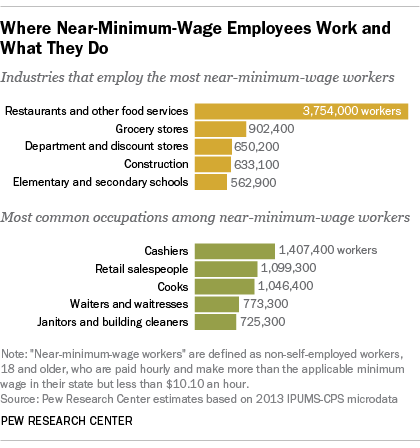As Fact Tank noted earlier this month, about 20.6 million people — 30% of all hourly, non-self-employed workers 18 and older — are what we call “near-minimum-wage workers,” meaning they earn more than the current minimum wage (either the federal $7.25-an-hour minimum or a higher state minimum) but less than the $10.10 hourly rate that emerged over the past year as a consensus goal of many Democrats and labor groups.
We first explored the demographics of this group by workers’ age, sex and race. But we also wondered what jobs they held and how much they earned, so we took another run through the public-use microdata from the 2013 Current Population Survey.
 As you might have guessed, the restaurant and food service industry is the single biggest employer of near-minimum workers. Last year, according to our analysis, that industry employed 3.75 million near-minimum workers, about 18% of the total. Many of those workers, presumably, are tipped, so their actual gross pay may be above $10.10 an hour. (Federal law, as well as wage laws in many states, allow tipped employees to be paid less as long as “tip credits” bring their pay up to at least the applicable minimum.)
As you might have guessed, the restaurant and food service industry is the single biggest employer of near-minimum workers. Last year, according to our analysis, that industry employed 3.75 million near-minimum workers, about 18% of the total. Many of those workers, presumably, are tipped, so their actual gross pay may be above $10.10 an hour. (Federal law, as well as wage laws in many states, allow tipped employees to be paid less as long as “tip credits” bring their pay up to at least the applicable minimum.)
Restaurant/food service is by far the leading employer of near-minimum workers aged 30 and younger: about 2.5 million, or nearly a quarter of all near-minimum workers in that age bracket. The industry, in fact, is the single biggest employer of every other age bracket as well, though not quite to such a preponderant extent.
 However, other industries are even more reliant on near-minimum-wage workers. Based on our estimates, industries where more than three-quarters of the hourly workers make more than minimum but less than $10.10 an hour include scrapyards, video-rental stores (the few remaining), mail-order houses, makers of mobile homes and other prefabricated buildings, and car washes.
However, other industries are even more reliant on near-minimum-wage workers. Based on our estimates, industries where more than three-quarters of the hourly workers make more than minimum but less than $10.10 an hour include scrapyards, video-rental stores (the few remaining), mail-order houses, makers of mobile homes and other prefabricated buildings, and car washes.
The picture looks slightly different when viewed by job rather than employer. We have occupational data for 19.5 million of the estimated 20.6 near-minimum workers, and according to our analysis the most common occupations for those workers are cashiers (1.4 million workers), retail salespeople (1.1 million) and cooks (1.05 million). (We do wonder a bit about the 11,000 or so near-minimum workers who gave their occupation as “chief executive.”)
We also looked at the wage distribution of the near-minimum workforce. Interestingly, nearly a quarter of them (about 5.1 million workers) are already close to $10.10 an hour, meaning an increase in the federal minimum to that level wouldn’t benefit them very much. More than a third, though — or roughly 7.4 million workers — make between $7.25 and $8.50 an hour.



